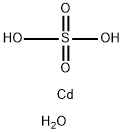| Identification | More | [Name]
Cadmium sulfate octahydrate | [CAS]
7790-84-3 | [Synonyms]
CADMIUM (II) SULFATE, HYDROUS
CADMIUM SULFATE, 8/3-HYDRATE
CADMIUM SULFATE HYDRATE
CADMIUM SULFATE N-HYDRATE
CADMIUM SULFATE-WATER(3/8)
CADMIUM SULPHATE 8/3-HYDRATE
Cadmiumsulfate(1:1)hydrate(3:8)
cadmiumsulphateoctahydrate
Sulfuricacid,cadmiumsalt,hydrate
CADMIUM SULFATE HYDRATE ACS REAGENT
CADMIUM SULFATE EXTRA PURE
CADMIUM SULFATE HYDRATE, 98+%, A.C.S. RE AGENT
CADMIUM SULFATE HYDRATE, ACS
CADMIUM SULFATE CRYSTALLINE
CADMIUM SULFATE HYDRATE 98+% A.C.S. &
CadmiumSulphateGr
Cadmium sulfate, 8/3-hydrate, reagent ACS, crystals
CADMIUM SULFATE, HYDRATED REAGENT (ACS)
CADMIUM SULFATE, HYDRATED, 99.99%
Sulfuric acid, cadmium salt (1:1), hydrate (3:8) | [EINECS(EC#)]
233-662-6 | [Molecular Formula]
CdH16O12S | [MDL Number]
MFCD02253000 | [Molecular Weight]
352.6 | [MOL File]
7790-84-3.mol |
| Chemical Properties | Back Directory | [Appearance]
Cadmium sulfate is a white to colorless, odorless, crystalline substance. | [Melting point ]
41 °C | [density ]
3.08 | [refractive index ]
1.565 | [storage temp. ]
Store at +5°C to +30°C. | [solubility ]
1130g/l | [form ]
Solid | [color ]
White | [Specific Gravity]
3.08 | [Odor]
Odorless | [PH]
3.0-6.0 (50g/l, H2O, 20℃) | [Stability:]
Stable. | [Water Solubility ]
Highly soluble in water. Partially soluble in methanol and ethyl acetate. Insoluble in ethanol. | [Merck ]
14,1627 | [Boiling point ]
>80°C(decomposition) | [Exposure limits]
ACGIH: TWA 0.01 mg/m3; TWA 0.002 mg/m3
NIOSH: IDLH 9 mg/m3 | [CAS DataBase Reference]
7790-84-3(CAS DataBase Reference) |
| Safety Data | Back Directory | [Hazard Codes ]
T+,N | [Risk Statements ]
R45:May cause cancer.
R60:May impair fertility.
R61:May cause harm to the unborn child.
R25:Toxic if swallowed.
R26:Very Toxic by inhalation.
R48/23/25:Toxic: danger of serious damage to health by prolonged exposure through inhalation and if swallowed .
R50/53:Very Toxic to aquatic organisms, may cause long-term adverse effects in the aquatic environment . | [Safety Statements ]
S53:Avoid exposure-obtain special instruction before use .
S45:In case of accident or if you feel unwell, seek medical advice immediately (show label where possible) .
S60:This material and/or its container must be disposed of as hazardous waste .
S61:Avoid release to the environment. Refer to special instructions safety data sheet . | [RIDADR ]
UN 2570 6.1/PG 3
| [WGK Germany ]
3
| [RTECS ]
EV2850000
| [TSCA ]
Yes | [HazardClass ]
6.1 | [PackingGroup ]
III | [HS Code ]
28332920 | [Safety Profile]
Confirmed human
carcinogen with experimental tumorigenic
and neoplastigenic data. Experimental
teratogenic and reproductive effects.
Mutation data reported. When heated to
decomposition it emits very toxic fumes of
Cd and SO,. See also CADMIUM
SULFATE, CADMIUM COMPOUNDS,
and SULFATES. | [Toxicity]
LD50 orally in Rabbit: 280 mg/kg |
| Hazard Information | Back Directory | [Potential Exposure]
It is used in pigments, electroplating;
as a fungicide; and in synthetic and analytical chemistry.
Also used in fluorescent screens; as an electrolyte.
Incompatibilities: Acts as a weak inorganic acid; neutralizes bases. Incompatible with oxidizers (chlorates, nitrates,
peroxides, permanganates, perchlorates, chlorine, bromine,
fluorine, etc.); contact may cause fires or explosions. Keep
away from alkaline materials, strong bases, strong acids,
oxoacids, epoxides, sulfur, selenium, tellurium, zinc | [First aid]
Move victim to fresh air. Call 911 or emergency
medical service. Give artificial respiration if victim is not
breathing. Do not use mouth-to-mouth method if victim
ingested or inhaled the substance; give artificial respiration with the aid of a pocket mask equipped with a one-way
valve or other proper respiratory medical device.
Administer oxygen if breathing is difficult. Remove and
isolate contaminated clothing and shoes. In case of contact
with substance, immediately flush skin or eyes with running water for at least 20 minutes. For minor skin contact,
avoid spreading material on unaffected skin. Keep victim
warm and quiet. Effects of exposure (inhalation, ingestion,
or skin contact) to substance may be delayed. Ensure that
medical personnel are aware of the material(s) involved
and take precautions to protect themselves. Medical | [Shipping]
UN2570 Cadmium compounds, Hazard Class:
6.1; Labels: 6.1-Poisonous materials, Technical Name
Required. | [Chemical Properties]
Cadmium sulfate is a white to colorless, odorless, crystalline substance. | [Chemical Properties]
White crystal or crystalline powder | [Uses]
Cadmium sulfate mainly used in electroplating of cadmium, which is used in electronic circuits. It is used as a precursor for cadmium based pigments such as cadmium sulfide and pharmaceutical intermediates. It is used in the standard weston cell. | [Uses]
Cadmium sulfate octahydrate is used in preparation of cadmium standards.
| [Uses]
In electrodeposition of Cd, Cu, and Ni; in phosphors, manufacture of standard cadmium elements; Cadmium sulfate octahydrate can be used as catalyst in the Marsh test for As, determining H2S and detecting fumaric acid; as nematocide, fungicide, bactericide; lubricant; electrolyte in Weston cell.
| [Definition]
ChEBI: A hydrate composed of cadmium sulfate and water in a 3:8 ratio. | [Purification Methods]
The sulfate crystallises from distilled water as a hydrate by partial evaporation in a desiccator. It gives the monohydrate on heating at 80o. It is insoluble in EtOH, Me2CO or EtOAc. It forms a white precipitate of Cd(OH)2 with aqueous NH3 which dissolves in excess of NH3 to form soluble [Cd(NH3)4]SO4. [Gmelin’s Cadmium (8th edn) 33 p 121 1925, Suppl pp 609-610 1959.] |
|
| Company Name: |
JSK Chemicals
|
| Tel: |
+919879767970 |
| Website: |
www.jskchemicals.com |
| Company Name: |
Merck Ltd
|
| Tel: |
+91-2262109800 +91-2262109000 |
| Website: |
www.merckgroup.com |
|





